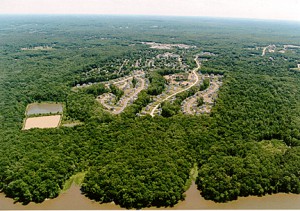Smart Conservation: The “Green” Side of Smart Growth
For an urban state, New Jersey ranks as a national leader in land conservation. We rank first in percentage of the farmland base preserved and fourth in absolute numbers of acres.
Since 1961, New Jersey voters have approved ten successive bond proposals to fund the “Green Acres” open space program, a remarkable showing of public support. We have nationally-acclaimed growth management programs, such as that for The Pinelands; and strong regulatory programs, for example for freshwater wetlands.
In round numbers, one-third of our state’s 4.7 million acres is developed. A fifth is publicly owned or deed-restricted parkland or farmland. Backed by a new, dedicated source of funds administered by a new agency, the Garden State Preservation Trust (GSPT), an additional 20 percent of the state has been targeted for purchase in fee or by easement, a “Million Acre Conservation Goal.”
Yet suburban tract housing, office parks, and commercial strips spread further into the open countryside every day. Suburban sprawl threatens water supplies, fragments woodlands and wildlife habitats, and “checkerboards” farming areas. Some analysts have estimated “build out” of New Jersey’s remaining buildable land in 30-50 years. And, as cities, older suburbs, and some small towns have deteriorated, so have their parks.
With the “Million Acre Goal,” state, county, and local governments – and independent land conservancies – are spending unprecedented sums for open space. Government and conservancy buyers see themselves as in a race with developers for critical sites. This means sharply rising land prices.
Public and private dollars – for purchase of land or development restrictions on land – are an indispensable foundation for New Jersey’s conservation achievements and expectations. But experience has made it clear that when it comes to resource conservation, farmland and parks – we can’t buy our way out of sprawl.
A tension between two sharply different land use regimes frustrates land conservation in New Jersey. On the one hand, we have the acquisition programs, dedicated to purchasing open space at real estate market values based on comparable sales. Countering this, we have the intractable complex of municipal zoning, sewerage, road building, and development approvals, as practiced by New Jersey’s 566 municipalities – all serving to drive up land values and in other ways obstruct conservation goals.
How can our citizens get more for the dollars that are dedicated by state and local government to preserving open lands and creating better park systems? Are there opportunities for greater efficiencies and effectiveness in the state’s land conservation programs?
Smart Growth is well known as the broad effort to direct development to older areas and new centers in good locations, while conserving the open countryside. Smart Conservation is the “green” side of smart growth. Its substantive goal is an interconnected, regional web of open and healthy recreational areas, ecosystems, wildlife habitats, water supplies and agriculture.
As government policy, Smart Conservation integrates tools often used to counter purposes today: land-use planning, regulation, spending on open space and infrastructure like roads and sewers, and tax policy. Smart Conservation also creates mutually supportive linkages between the actions of state and local government. In New Jersey (outside the 927,000 acres of the Pinelands that is governed under a special statute) the elements of Smart Conservation are at best disconnected from, and at worst directly in conflict with, natural resource and farmland preservation.
New Jersey Future has reviewed our state’s land conservation programs. We have researched alternative models from other jurisdictions. This new report offers a complete listing of our findings and in a separate document we share our recommendations.
Download report:
Smart Conservation: The “Green” Side of Smart Growth (PDF)
Smart Conservation Recommendations (PDF)












